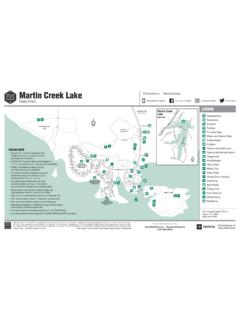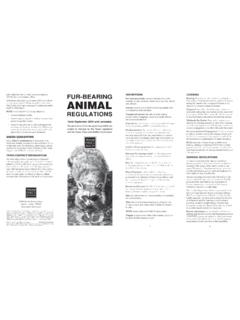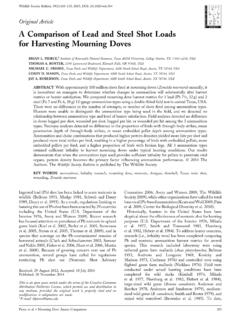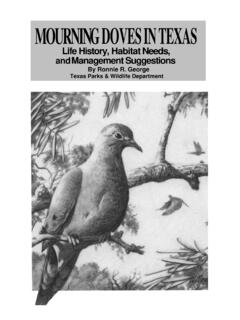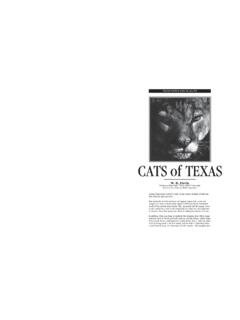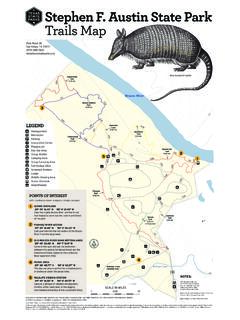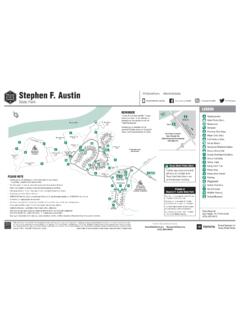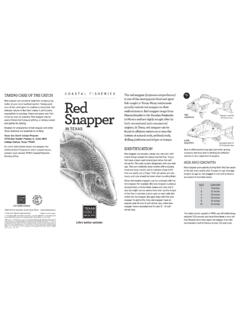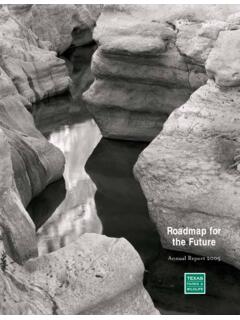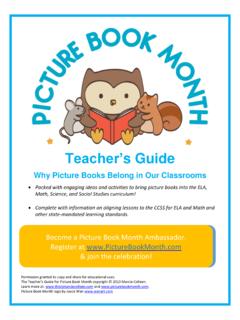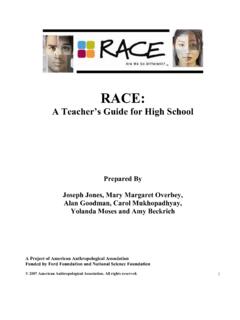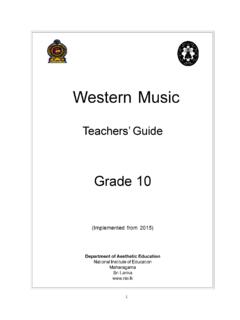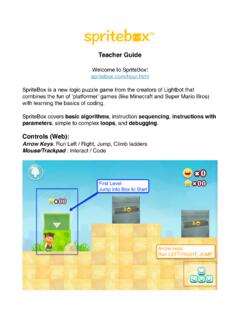Transcription of Teacher Guide: Texas Aquatic Science
1 Texas Aquatic scienceA joint projectTexas Parks and Wildlife DepartmentThe Meadows Center for Water and the Environment, Texas State UniversityHarte Research Institute for Gulf of Mexico Studies, Texas A&M University - Corpus ChristiTeacher guide to Aquatic Science and Ecosystems Curriculum for Middle School and High SchoolFrom Molecules to Ecosystems, and Headwaters to OceanTexas Aquatic Science Teacher guide Author Sandra Johnson, Project Directors Rudolph Rosen, Ph. D., Meadows Center for Water and the Environment Nancy Herron, Texas Parks and Wildlife Department A Joint Project of Texas Parks and Wildlife Department The Meadows Center for Water and the Environment at Texas State University The Hart Research Institute for Gulf of Mexico Studies at Texas A&M University-Corpus Christi Funding Support by The Ewing Halsell Foundation, San Antonio Sport Fish Restoration Program, Department of the Interior Special Acknowledgement The Missouri Department of Conservation produced an Aquatic Science guide for students and teachers that served as a model for our work in Texas .
2 We wish to thank them for their willingness to allow us to use and adapt materials from their student and Teacher guide for Conserving Missouri s Aquatic Ecosystems. A Comprehensive Aquatic Science Curriculum Texas Aquatic Science is a curriculum consisting of a Teacher guide , student reading text and guide , specially produced videos, and ancillary materials. * * * Copyright 2013 by the Texas Parks and Wildlife Department; The Meadows Center for Water and the Environment, Texas State University; and The Hart Institute for Gulf of Mexico Studies, Texas A&M University-Corpus Christi Non-Commercial/Educational Use: The information, drawings and/or photos in this publication may be used for "noncommercial and/or educational" usage as long as they are not reproduced for sale or presented as original works. Credit lines must be maintained if already displayed on any page or other material.
3 Reproduced information that is utilized verbatim should be credited as follows: Information courtesy of Texas Aquatic Science partners: Texas Parks and Wildlife, The Meadows Center for Water and the Environment, and the Harte Research Institute for Gulf of Mexico Studies." Preface | 2 Table of Contents Acknowledgements About the Author About the Partners TEKS in Texas Aquatic Science TEKS in Teacher guide Lessons: Texas Aquatic Science Introduction Chapter 1: Water Is Life What Do I Know About Water? Water Distribution and Scarcity Properties of Water: Polarity, Cohesion, Adhesion Properties of Water: Three States: Solid, Liquid, Gas Properties of Water: Surface Tension Properties of Water: Ability to Dissolve Other Substances Investigating Water Consumption Reading and Research Student Investigation of Water Quality Chapter 2: The Ultimate Recyclable How Does Water Cycle? The Water Cycle: Weather and Climate Water Runoff and Infiltration Infiltration and Aquifers Reading and Research Tap Water and Wastewater Chapter 3: Watersheds and the Land What Is a Watershed?
4 Topography and Watersheds Land Use in our Watershed Texas Watersheds, Ecoregions and Physiographic Regions Reading and Research Chapter 4: Living In Water Apt Adaptations Reading and Research Fish Lab and Comparison Matrix Preface | Field Trip: Collecting for a Native Aquarium Aquatic Organism Comparison Matrix Native Aquarium Investigation Chapter 5: From Sun to Sunfish Interactions of Living Things Competition Within the Frio Pond Community Student Reading and Research What s My Niche? Native Aquarium Observations Aquatic Food Web Scramble Chapter 6: Texas Many Aquatic Ecosystems It s All Part of a System Texas Waters Reading and Research The Hunt for Biodiversity Measuring Populations Conserving Aquatic Ecosystems Chapter 7: Aquifers and Springs What Springs to Mind? Reading and Research A Moving Experience Building a Model What Endangers Species? Weird Creatures of Aquifers and Springs Chapter 8: Streams and Rivers What Do I Know?
5 What Do I Want to Find Out? Reading and Research Where Do I Live? What Do I Eat? The Key to Invertebrate Identification Assessing Stream Health with Invertebrate Sampling Chapter 9: Lakes and Ponds Characteristics of Lakes and Ponds Reading and Research Changing Environments: Pond Succession Aquatic Invasion Micro-organisms in Ponds Preface | 4 Chapter 10: Wetlands What Is a Wetland Reading and Research Wetland Food Webs Migration Stations Field Trip to a Wetland Chapter 11: Bays and Estuaries What Do We Know about Bays and Estuaries? Reading and Research Salinity The Ups and Downs in an Estuary Ecosystem Services Chapter 12: Oceans The Gulf of Mexico ABC s of the Gulf Reading and Research Ocean Currents Wind and Waves Researching Ocean Organisms and Food Webs Field Trip to the Gulf of Mexico Chapter 13: Fishing for Conservation Gone Fishing? Which Fish Am I? Reading and Research Fishing Line Experiment Fish Sampling and Ecosystem Assessment Chapter 14: Water for People and the Environment Who Owns the Water?
6 Reading and Research What s the Pollution? Water Conservation Preface | 5 Acknowledgments Texas Parks and Wildlife Department Nancy Herron, Outreach and Education Director at Texas Parks and Wildlife Department provided leadership direction on educational content and review of the text, along with staff members Caleb Harris, Karen Marks, Susan Loomis, Cappy Smith, Kiki Corry, Lee Smith, and Chase Fountain. Missouri Department of Conservation We wish to acknowledge the generous partnership of the Missouri Department of Conservation (MDC), most specifically Mike Huffman, Regina Knauer, Jack Woodhead, Elaine Callaway, Melanie Carden-Jessen, and Mary Scott for their contribution, support for the project, and permission to use and adapt MDC materials in the production of Texas Aquatic Science and the Teacher guide . Contributors and Reviewers Timothy Birdsong, David Bradsby, Lisa Brown, Valerie Bugh ( ), Ron Coley, Corpus Christi Caller Times, Kiki Corry, Shannon Davies, Kelly Drinnen, Ducks Unlimited Canada, Ducks Unlimited, Inc.
7 , Carolyn Chipman Evans, Chase Fountain, Stephan Magnelia, Dakus Geeslin, Mary Gomillion, Denise Gordon, Sharla Gutierrez, Caleb Harris, Jennifer Idol (the Underwater Designer), The In-Fisherman, Ron Kabele, Susan Loomis, Allison Knight, Gordon Linam, Cindy Loeffler, Stephan Magnelia, Jennifer Mandel Buratti, Karen Marks, Sam Massey, Randall Maxwell, Kevin Mayes, Captain Mike McBride, Larry McKinney, Heather Millar, Meredith Miller, Warren Pullich, Steve Quinn, Shelly Rosen, Margaret Russell, Olivia Sanchez, Andrew Sansom, Lindsay Sansom, Donna Shaver, Kris Shipman, Patt Sims, Cappy Smith, Lee Smith, Jessica Snyder, Greg Southard, Gail Sutton, Brenda Templeton, Travis Tidwell, Jace Tunnell, Wes Tunnell, Emily Warren, Terry Wendland, Donna Work, Scott Yaich, and Brian Van Zee Editing, Graphics, Technical Review, and Design A special thanks goes to Dr. Rudolph Rosen for editing, design work, graphics, and production of Texas Aquatic Science Teacher guide , information and technical review, and invaluable help on this project.
8 Cover Photo Texas Parks and Wildlife Preface | 6 About the Author Sandra Johnson, Dr. Sandra Johnson specializes in writing Science curriculum aligned with state curriculum standards and conducting professional development for teachers. Dr. Johnson is a former Teacher with experience with kindergarten, elementary, secondary, and gifted and talented students. She served as Science Consultant for Region XIII Education Service Center serving 59 school districts training teachers in kindergarten, elementary, and secondary classrooms. In addition, she has taught at both the University of Texas in Austin and Texas A&M Corpus Christi. She is an educational consultant providing curriculum writing for a number of non-profit educational and conservation organization and conducts professional development for teachers all over Texas . Preface | 7 About the Partners Texas Parks and Wildlife Department Texas Parks and Wildlife is the state agency charged with the management of the state's fish, wildlife and parks, and the habitats upon which they rely.
9 In a state whose population is 86% urban and land is 95% privately owned, TPWD relies on the understanding and cooperation of Texans for conservation of natural resources. Studies have shown that most Texans don't know where their drinking water comes from and struggle to navigate environmental issues. With the long-term challenges our state faces, such as how to provide water for people and the environment, TPWD believes building Science -based knowledge and outdoor experiences are essential to developing the critical skills Texans will need to make informed decisions about the future of our natural resources. TPWD was a leader in forging a public-private partnership to develop the Texas Children in Nature strategic plan and network of regional efforts, and in the development of the companion Texas Natural Resource/Environmental Literacy Plan. TPWD was inspired by the work of the Missouri Department of Conservation's Aquatic ecosystem curriculum for schools and obtained permission to adapt their guide for Texas .
10 TPWD engaged two of Texas ' most trusted leaders in water issues as partners for this project. The Meadows Center for Water and the Environment, Texas State University Located at the San Marcos Springs, on the Texas State University campus, The Meadows Center for Water and the Environment s core mission is to develop and promote programs and techniques for ensuring sustainable water resources for human needs, ecosystem health, and economic development. The Meadows Center engages in a holistic approach to the management of natural systems where key principles of sustainability and equitable use guide sound water policy. Work includes the following: Advancing scientific and technical knowledge through research on Aquatic resources Identifying and analyzing socio-economic and political issues affecting water use Guiding the development of environmentally sustainable public water policy in Texas Cultivating public awareness and education about water resource issues At Texas State, The Meadows Center serves as an integrating mechanism for the university s multidisciplinary expertise in Aquatic resources.
